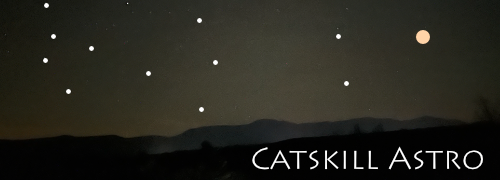Arp’s Peculiar Galaxies
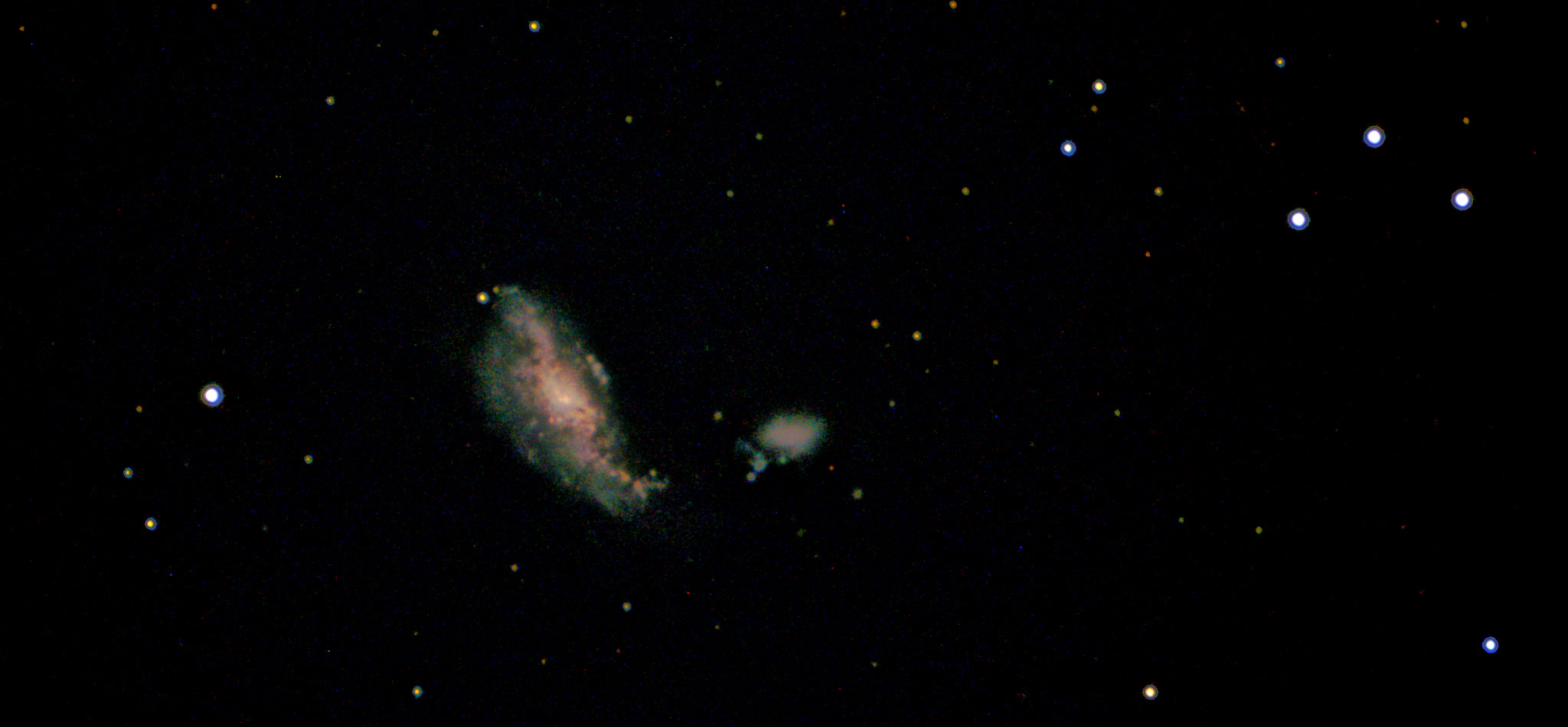
Page 8 of 16
Arp observations 71-80 of 155 total to date.
| Thumbnail | Title/link | Arp Category | Date Observed | Observer Description |
|---|---|---|---|---|
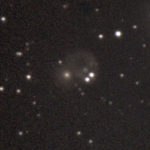 |
Arp 145 / UGC 1840 | Material emanating from elliptical galaxies | 2024-02-29 20:00:01 | Reviewing this before submission to the AL in Feb 2025, a year after the original capture,, I feel the same about this target as I do Arp 141: this is as likely to be a merger as a showing "emanating material". As part of this "rethinking", I created the inverted monochrome image from my original OSC capture, which depicts things much more clearly in combination with the positive. The galactic center of the elliptical galaxy is obviously the large, medium-bright object just left of image center (the three stars in a line are lower in the image and point to it). All of the other bright objects are imo field stars, EXCEPT the medium bright object which forms the upper vertex of a triangle in combination with the two brightest field stars. If you look at my inverted image, it's the smallest of the three. If believe this could be the center of a spiral galaxy being absorbed into the Elliptical rather than emanating from it. This capture took place despite an 88% moon. I was determined to capture a number of Arp galaxies in Andromeda, recognizing the window of opportunity in Feb 2024 was short. This was the second observation of the evening, and the target was fairly low in the west. I captured as much data as I could until I judged the thicker atmosphere and glow at the horizon would render further integration useless. |
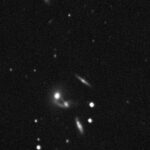 |
Arp 150 / NGC 7609 | Galaxies with jets | 2024-11-03 21:36:00 | Arp's designated this cluster as one of a group of "Galaxies with jets." The image suggests that NGC 7609 is in fact two galaxies, a larger one (left) connected to a smaller one by two major arms. The "jet" is likely the emanations from the smaller 7609 galactic center, but that's just a guess. It's more readily seen as an inverted (negative) image, so I prepped the "comparison" accordingly. |
 |
Arp 151 / Markarian 40 | Galaxies with jets | 2025-05-11 22:42:00 | The first observation following a clear day, but with a full moon. As it turned out clear enough. |
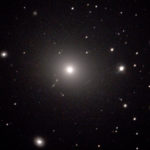 |
Arp 152 / Virgo A / M87 | Galaxies with jets | 2024-03-13 00:42:00 | The fourth of 9 entries added to the Messier catalog on March 8, 1781, also (#37) credited to Messier. "Nebula without star, in Virgo, below & very near a star of eighth magnitude.... This nebula appears at the same luminosity as the two nebulae Nos. 84 and 86." Halton Arp included M87 as Arp 152 in his Atlas of Peculiar Galaxies. He classified it with "Galaxies with Jets" and remarked "Short exposure to show jet. Virgo A radio source." <--> The toughest aspect for me was to set the black level appropriately to show the diffuse outer ring of this nebulous, elliptical galaxy while not obscuring the jet(s)... It's so large, I thought for a while my dark-subtraction in SharpCap was failing, and I was seeing amp glow! However, I was able to identify that the diffusion wasn't quite round, and not "quite" as large as uncontrolled amp-glow with my 294 sensor. This became obvious after about 15m of integration. The S/N ratio was so high, and since there is no structure to speak of in the outer disc, there seemed no advantage to continuing integration longer than the 25m once the two tiny galaxies, LEDA 139919 and UGC 7652, and the connecting jet were clear. Note that the "short exposure" Arp alludes to allows his image to show the jet right to the galactic center. My exposure wasn't so expert, and the inverted image is still blown out, but does appear to show the jet continuing a little deeper into the disk. Then a friend pointed out that it's actually second "jet" in this image that Arp did not detect: which appears as a tiny bump on the edge of the galactic core. You can see it the enlarged closeup is in the gallery. It is barely visible in the Arp photograph; note the Arp comparison is rotated 180° relative to the original capture, featured image, and jet enlargement. |
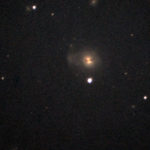 |
Arp 155 / NGC 3656 | Galaxies disturbed by interior absorption | 2024-03-12 13:38:32 | The first challenge here is understanding what "disturbed by interior absorption" means. I searched carefully on the Internet for a definitive source and found found nothing very convincing. As is typical in the Arp world, many sources quote the category but explain nothing, as if Arp's perceptions were self-evident (they often aren't, I find). So I'm falling back onto the common meanings of these words, which would be a galaxy where the interior of the disk is seriously disturbed or disrupted. Examining the galaxies so categorized (153-160), I can confirm that this describes all of them to some degree. Certainly, in the case of Arp 153. the galaxy appears to be lenticular, but the core is bifurcated and divided by large dust lanes. This seems consistent with a galaxy consolidating its core after a merger. |
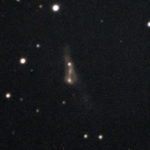 |
Arp 158 / NGC 537 | Galaxies disturbed by interior absorption | 2024-02-29 19:39:57 | This is a highly disturbed galaxy, no doubt, but I'm a bit puzzled why "disturbance of interior absorption" is the most salient feature here. As a first approximation, young galaxies start with a coherent shape, often sprial and circular. As the galaxy matures and evolves through gravitational interactions with other galaxies, some sort of elliptical shape is often preserved, as well as a high degree of symmetry. This galaxy has been severely elongated in one direction and cut off in the other. The core appears to be separated into two planes: the top level, smaller, perhaps showing the remnants of a formerly "S" curved bar. The lower level, perhaps twice as long, and rotated counter-clockwise 10 or 15 degrees. |
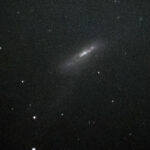 |
Arp 159 / NGC 4747 | Galaxies disturbed by interior absorption | 2024-06-12 23:52:00 | This is a fascinating and challenging observation. NGC 4747 is a barred spiral galaxy categorized by Arp as exhibiting disturbances due to "interior absorption" which seems reasonably apt in this case. On the image, North is left. The overall galaxy appears elongated, though this may be exaggerated by the relatively low angle of view. The central disk, normally centered, is offset up and to the right. Huge knots are visible on both ends of core. The bright "core", usually circular, exhibits two, possibly three bright, circular centers, almost as if they were beaded. A huge debris trail flows from the lower left to underneath the core and is unconnected to any object near the far end. Merger relics? |
 |
Arp 165 / NGC 2418 | Galaxies with diffuse filaments | 2024-03-13 11:51:43 | This is one of my early Arp observations, and it benefited substantially when I reviewed it in preparation for submission. It was captured on an otherwise clear, moonless evening, when we experienced a thin layer of high clouds that limited integration time. The key problem then becomes how to process the image to show the "diverse filaments". My original processing of the color image wasn't terribly effective. I've since learned that working with a monochrome, inverse image -- even ones converted from an OSC color image -- can be very powerful. An advantage here is that other than converting to monochrome and tuning the white, black, and gamma levels, you really don't need to stretch the inverse image at all. The relatively low light gathering power of the EdgeHD also makes it easy to distinguish field stars (which are dark circles in inverse) versus small galaxies, which are light gray smears. Most of the darker filaments seem to point to such smears, particularly the main filament which you can see clearly in my capture at the root. It appears to point to three galaxies on a similar line, including the largest which is almost dead center on the north border of the comparison image. There's a second galaxy, just SE, and the smallest galaxy of the three, slightly SW, closer to NGC 2418. The 200" Hale telescope resolves the filament further up the image, but, hey, the Rockefeller's didn't pay for my telescope. It's worth looking at the color comparison image as these three galaxies are easily color-differentiated from the field stars and you can distinguish the core and disk on the two larger galaxies. Also in my capture, you can also see how some of the filaments are skewed NE towards several faint smears (N is up, East is counter clockwise from center), as well as NW towards another tiny galaxy.. The Hale telescope has so much light-gathering power that these tiny galaxies are nearly indistinguishable from field stars. |
 |
Arp 166 / NGC 750-51 | Galaxies with diffuse filaments | 2024-02-21 19:30:17 | Brief observation due to cloud conditions. This is another early observation that benefited from reprocessing prior to submission as an inverted image. The two, main elliptical galaxies, NGC 750 and 751 are evident enough, as are the filaments that connect them. In some ways, here, the limited light capture is helpful, as the two galactic centers are distinct, whereas they're blown out, and virtually merged in the original Arp image. The key "diverse filament" stretches to the NW (clockwise is West) to a dwarf galaxy. In the Arp image, you can resolve a spiral structure with an extended tail in the opposite direction. On my capture, this galaxy is barely a squiggle in the inverted image, and invisible in the color version. Nonetheless, while not nearly as distinct as in Arp's image, the NW trending filament is clearly visible in the inverted image. It is slightly visible as a brownish cast to the background in the color image, though admittedly I missed it in my original analysis. BTW, this is yet another pair of galaxies discovered by William Herschel in the late 18th century. |
 |
Arp 167 / NGC 2672 | Galaxies with diffuse counter-tails | 2024-03-24 23:43:00 | The two galaxy centers, NGC 2672 (the larger) and 2673 (the smaller) were evident in SharpCap from virtually the first frame. Time was required to capture the diffuse plumes which you can see, with sufficient time. Arp remarks, "Comp[anion]. galaxy very condensed, has curved plume". With North right, and East counter-clockwise, there's a hint of curvature towards the SE, comparing the density of the plume to the NE. This is slightly more clear in the inverted image, though the color image may be nearly as clear. |
